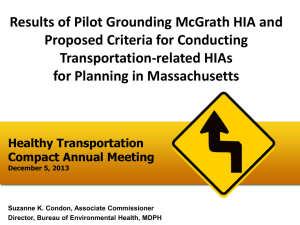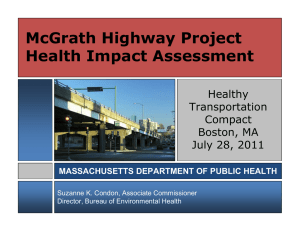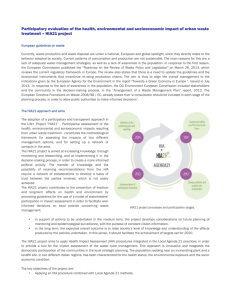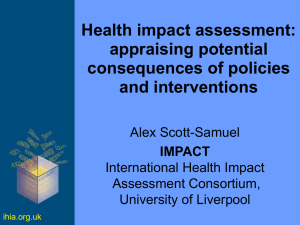Health Impact Assessments: The Massachusetts Experience Healthy Transportation Advisory Council Meeting
advertisement
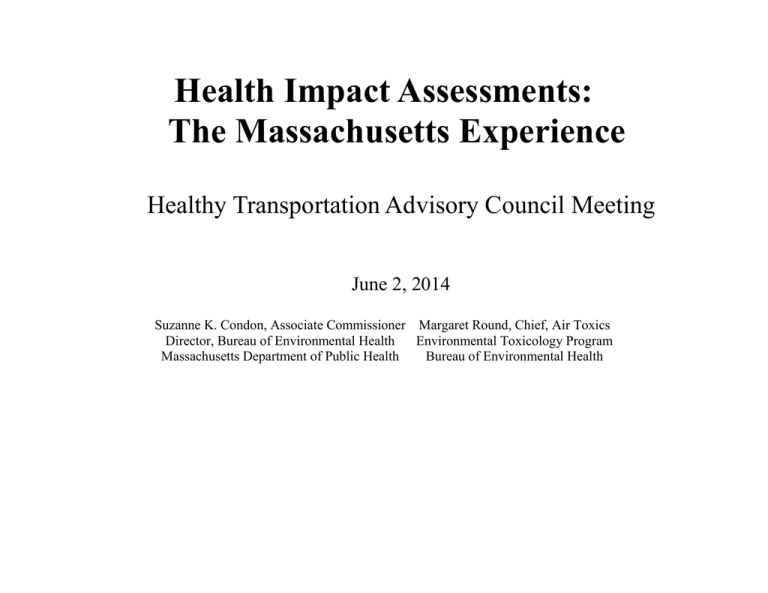
Health Impact Assessments: The Massachusetts Experience Healthy Transportation Advisory Council Meeting June 2, 2014 Suzanne K. Condon, Associate Commissioner Margaret Round, Chief, Air Toxics Director, Bureau of Environmental Health Environmental Toxicology Program Massachusetts Department of Public Health Bureau of Environmental Health Outline I. II. Introduction: Steps of an HIA Examples of Health Impact Assessments in Massachusetts Transportation Reform In Massachusetts III. Examples of Baseline Health Data Available for HIAs IV. Possible Criteria To Target Transportation Projects Where HIAs Might Be Most Useful V. Summary I. Steps of HIA Screening Scoping Identify and prioritize topics for HIAs Identify health issues to be studied Prioritize Research questions Assessment Conduct literature reviews Research existing conditions data Conduct surveys, interviews, focus groups Conduct data analysis Interpret and ground truth data Recommendations Identify and prioritize recommendations Reporting Write, review and edit final report Develop a communication, media and advocacy plan to report findings on decision makers Monitoring Collect data on impacts Hold decision-makers accountable for decision agreements and mitigations II. Examples of HIA Topics Addressed in Massachusetts The HIA work at MDPH is a collaborative effort between the Bureau of Environmental Health and Bureau of Community Health and Prevention: Development of a Rail Trail* Speed limits* Rail trail development* Development private equity fund to support transit oriented development projects * Transportation planning study* Multi-use development of land parcels Implementing HIAs in Massachusetts Assess baseline health outcomes o Elevated childhood obesity was identified in study area Compare baseline data with environmental exposure data to understand health impacts o Disease burden expected to be reduced based on projected reduction in exposures associated with motor vehicle emissions DPH/BEH maintains robust data sets available for assessing environmental exposures and health outcomes to address health equity concerns o Health Data: cancer, pediatric asthma data at neighborhood level o Environmental Data: air quality and water quality Transportation Reform in Massachusetts Transportation Reform Law In June 2009 Governor Deval Patrick signed the Transportation Reform Law - M.G.L. Chapter 6C The primary goal was to consolidate all transportation agencies in MA to reduce duplicate efforts and enhance transportation planning Picture of Governor Deval Patrick signing the bill into law. Healthy Transportation Compact Under M.G.L. Chapter 6C, Section 33 the Healthy Transportation Compact is directed to: o (v) establish methods to implement the use of health impact assessments (HIAs) to determine the effect of transportation projects on public health and vulnerable populations; and o (x) institute a health impact assessment for use by planners, transportation administrators, public health administrators and developers. Transportation planning projects often have a range of health implications that are not uniformly considered but can be now with EPHT data MDPH was awarded funds from the RWJ/Pew Health Impact Project to conduct a transportation-related HIA Interagency Working Group Monthly meetings beginning in late 2009 Discussion about: o What is an HIA – do we need a MA definition? o Need for cross agency framing to develop common understanding Inventory by agencies of interagency work related to transportation o What worked best? o What hurdles were met? Greater clarity on what is involved in existing transportation planning process Identification of a transportation project that could benefit from early incorporation of HIA into decision making process III. Transportation Reform in Massachusetts Overall Goal to Meet HIA Directives of Transportation Reform The goal of the proposed transportation-related HIA project is to work together with MassDOT, EEA and other community representatives to: Pilot an HIA Pilot an HIA of a proposed transportation related project Serve as a vehicle for training staff responsible for implementing the HIA directives III. Transportation Reform in Massachusetts Provide the framework for developing methods to determine which types of transportation projects might benefit from an HIA and the process to make such determinations Background on “Grounding McGrath” Study Project underway by the MassDOT that the HIA will inform is “Grounding McGrath” Study in Somerville, MA o Overall this transportation project aims to determine the future of the Route 28 corridor o MassDOT indicated that the size of the investment necessary to restore the highway provided an opportunity to evaluate the feasibility, benefits, impacts, and costs of removing at least a portion of the elevated structure on Route 28/McGrath Highway o MassDOT’s existing study protocol lends uniquely to the HIA process including establishment of an Advisory Group composed of community representatives to evaluate alternatives The HIA will provide supplemental health data analyses to augment the “Grounding McGrath” Study to promote decision making for optimal transportation design III. Transportation Reform in Massachusetts Picture of McGrath-Obrien Highway and Aerial view of McGrath Highway, Somerville, MA by Google Maps 6/18/2010 III. Examples of Baseline Health Data For Consideration in HIA Health Determinants Air pollution – high gradient near roadways and scientific evidence that continues to emerge regarding health impacts Access to active transportation and increasing physical activity (e.g., access to sidewalks, bicycle paths) Access to public transit mobility for vulnerable populations (people with disabilities, elderly) Traffic Safety Data Sources Health Outcomes Respiratory disease/illness (e.g., asthma), cardiovascular disease (e.g., heart attack), all-cause mortality, certain cancers Benefits for reducing obesity, diabetes, cardiovascular disease, premature mortality, improved mental and physical health Access to goods/services that support health, such as groceries, clinics Injury to pedestrians, vehicle drivers, and cyclists Economic: vitality of small businesses; property values and health care costs that could be reduced based on HIA outcomes Multiple indirect impacts on health Environmental Justice Multiple indirect impacts on health MDPH Bureau of Environmental Health Environmental Public Health Tracking (EPHT) Portal http://matracking.ehs.state.ma.us/ MDPH Bureau of Community Health and Prevention MassDOT MassDOT Economist to be hired EEA/MDPH EPHT/MassDOT Vulnerable Populations: Environmental Justice Areas Vulnerable populations defined using EOEEA designation of an Environmental Justice community o The median annual household income is at or below 65 percent of the statewide median income for Massachusetts; or o 25 percent of the residents are minority; or o 25 percent of the residents are foreign born, or o 25 percent of the residents are lacking English language proficiency Image of Map showing Environmental Justice Criteria met according to the American Community Survey, 2006-2010 EJ Criteria: Income, Minority Population, foreign-born, English Proficiency & Education Boulevard alternative shown as a reference point. Highlights of Findings Two optimal alternatives are the Boulevard Alternative and Boulevard with Inner Belt Connection Alternative because they offer the greatest opportunities for mobility and access. o The fact that significantly more children are currently obese compared to the statewide average indicated that alternatives that promote healthy behaviors are paramount. o Given that the study area is classified as an Environmental Justice community, it is critical that long-term plans that involve current residents are developed to ensure affordability of goods and services, stabilization of the cost of rental apartments, and employment opportunities are made available. Conducting an HIA in tandem with the first phase of a transportation planning study can provide good preliminary information on health impacts at an early stage of project development. However, a more detailed and precise assessment of health impacts and benefits of proposed alternatives would be possible at a later stage of project development, once more robust project-specific information and transportation data become available. Existing, publicly available health data resources, such as the MDPH/BEH Environmental Public Health Tracking portal (matracking.ehs.state.ma.us), are available to asses existing health conditions and potential health impacts associated with transportation projects. Possible Criteria for Incorporating HIA into Other Transportation Projects Roadway Projects Traffic volumes significantly increase Transit and Train Projects Significant increases or decreases in service Airport Projects Significant increase in number of flights Highway expansion projects New stations or stations to be decommissioned Addition of new runways Projects that increase motor vehicle emissions to residents within 300m Any changes that could result in mode shift (e.g. between train, transit, walking, biking) Change in size, type of aircraft Change will result in additional traffic to airport Changes that could result in mode shift (e.g. car to walking, biking, transit New parking areas that may increase idling/PM exposure Changes that will result in shorter distances from runways or taxiways to residents Significant changes that could result in housing destruction or displacement of residents Significant changes that could result in housing destruction or displacement of residents Changes in access to goods and services Changes in access to goods and services Additional Thoughts for Targeting Transportation Projects Where HIAs Might Be Most Useful In addition to the criteria by transportation mode, some projects subject to the Massachusetts Environmental Policy Act (MEPA) might be considered: 1. Any transportation project that will exceed MEPA (301 CMR 11.00) Review Thresholds, with particular regard to those Thresholds in the Transportation Category (301 CMR 11.03 (6)) 2. An HIA for any transportation project that has the potential to impact an Environmental Justice (EJ) population. The policy participation and enhanced analysis of impacts and mitigation under MEPA for projects that exceed thresholds for air, water, hazardous waste (other than remediation projects) or wastewater and sewage sludge treatment and disposal Also proposed using HIA as a decision support tool in climate change adaptation planning at the local level in MA Summary HIAs provide unique opportunity for public health officials to work collaboratively across agencies and secretariats. MDPH will present findings and recommendations to the Healthy Transportation Compact in December 2013 along with proposed criteria for determining which transportation projects might best benefit from an HIA The HIA will now go through the MEPA process. This will provide an opportunity to determine if HIAs facilitates that process Transportation reform in MA allows us to explore and establish optimal HIA methodologies Use of HIAs in transportation planning and projects subject to MEPA promotes national HIA planning efforts



